Overview
Anterior cervical discectomy and fusion (ACDF) is a surgery to remove a herniated or degenerative disc in the cervical spine (Fig 1). The incision is made through an anterior cervical (neck) approach. After the disc is removed, a bone graft is inserted to fuse together the bones above and below the disc space. An anterior cervical decompression and fusion would be recommended if physical therapy or medications fail to relieve your neck or arm pain caused by pressure on the spinal nerve roots. Patients typically go home the next day; recovery time takes approximately 4 weeks.
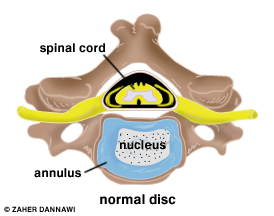
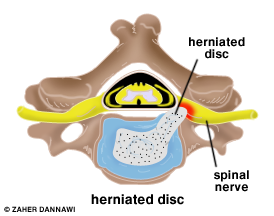
Figure 1, top. (top view of vertebra) Degenerative disc disease causes the discs (blue and white dotted) to dry out. Tears in the disc annulus can allow the gel-filled nucleus material to escape and compress the nerve in its nerve root canal (foraminal stenosis). The pinched spinal nerve becomes swollen and painful.
What is an anterior cervical discectomy & fusion (ACDF)?
Discectomy means "cutting out the disc." A discectomy can be performed anywhere along the spine from the neck (cervical) to the low back (lumbar). The damaged disc will be reached from the front (anterior) of the spine through the neck area. By moving aside the neck muscles, trachea, and esophagus, the disc and bony vertebrae are exposed. Surgery from the front of the neck is more accessible than from the back (posterior) because the disc can be reached without disturbing the spinal cord, spinal nerves, and the strong neck muscles. Depending on your particular symptoms, one disc (single-level) or more (multi-level) may be removed.
After the disc is removed, the space between the bony vertebrae is empty. To prevent the vertebrae from collapsing and rubbing together, a spacer (cage) with bone graft is inserted to fill the open disc space. The graft serves as a bridge between the two vertebrae to create a spinal fusion. Following surgery the body begins its natural healing process and new bone cells grow around the graft. After 3 to 6 months, the bone graft should join the two vertebrae and form one solid piece of bone.
The neck movement post fusion depends on the neck mobility before surgery and the number of levels fused. If only one level is fused, you may have similar or even better range of motion than before surgery. If more than two levels are fused, you may notice limits in turning your head and looking up and down. Motion-preserving artificial disc replacements have emerged as an alternative to fusion. Similar to knee replacement, the artificial disc is inserted into the damaged joint space and preserves motion, whereas fusion eliminates motion. Outcomes for artificial disc compared to ACDF are similar, but long-term results of motion preservation and adjacent level disease are not yet proven.
Who is a candidate?
You may be a candidate for discectomy if you have:
- diagnostic tests (MRI, CT, myelogram) show that you have a herniated or degenerative disc
- significant weakness in your hand or arm
- arm pain worse than neck pain
- symptoms that have not improved with physical therapy or medication
ACDF may be helpful in treating the following conditions:
Bulging and herniated disc: The gel-like material within the disc can bulge or rupture through a weak area in the surrounding wall (annulus). Irritation and swelling occurs when this material squeezes out and painfully presses on a nerve.
Degenerative disc disease: As discs naturally wear out, bone spurs form and the facet joints become inflamed. The discs dry out and shrink, losing their flexibility and cushioning properties. The disc spaces get smaller. These changes lead to canal stenosis or disc herniation (Fig. 1).
The surgical decision
Most herniated discs heal after a few months of nonsurgical treatment. Approximately 10-20% of people with herniated disc problems have enough pain after 6 weeks of conservative treatment to consider surgery.
What happens before surgery?
You will be seen in the preassessment clinic, several days before surgery, where preoperative investigations (e.g., blood test, electrocardiogram) will be carried out. Some medications need to be continued or stopped before the day of surgery.
Stop taking blood thinning medications ( Warfarin and Clopidogrel) 7 days before surgery. Aspirin should also be discontinued 5 days before surgery. You should stop eating or drinking 6 hours before surgery; however, you can continue to have clear fluid (e.g water) up to 2 hours before surgery.
Smoking
The most important thing you can do to ensure the success of your spinal surgery is quit smoking. Nicotine prevents bone growth and puts you at higher risk for a failed fusion. Patients who smoked had failed fusions in up to 40% of cases, compared to only 8% among non-smokers. Smoking also decreases your blood circulation, resulting in slower wound healing and an increased risk of infection.
What happens during surgery?
You will lie on your back on the operative table and be given anesthesia. Once asleep, your neck area is cleansed and prepped.
An approximately 2-inch skin incision is made on the left side of your neck. The spine will be accessed by moving aside muscles in your neck and retracting the trachea, esophagus, and arteries. Finally, the muscles that support the front of the spine are lifted and held aside to see the bony vertebrae and discs.
With the aid of a fluoroscope (a special X-ray), a thin needle is passed into the disc to locate the affected disc. The vertebrae bones above and below the damaged disc are spread apart with a special retractor.
The outer wall of the disc is cut (Fig 2). Approximately 2/3 of your disc will be removed using small grasping tools, and then a surgical microscope will be used to remove the rest of the disc.
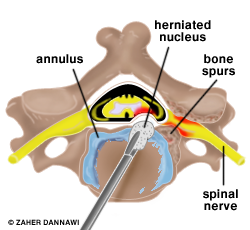
Fig 2. Disc removal using a grasing tool.
The ligament that runs behind the vertebrae is removed to reach the spinal canal. Any disc material and bony overgrowths pressing on the spinal nerves and cord are removed to ensure an adequate decompression (Fig 3).
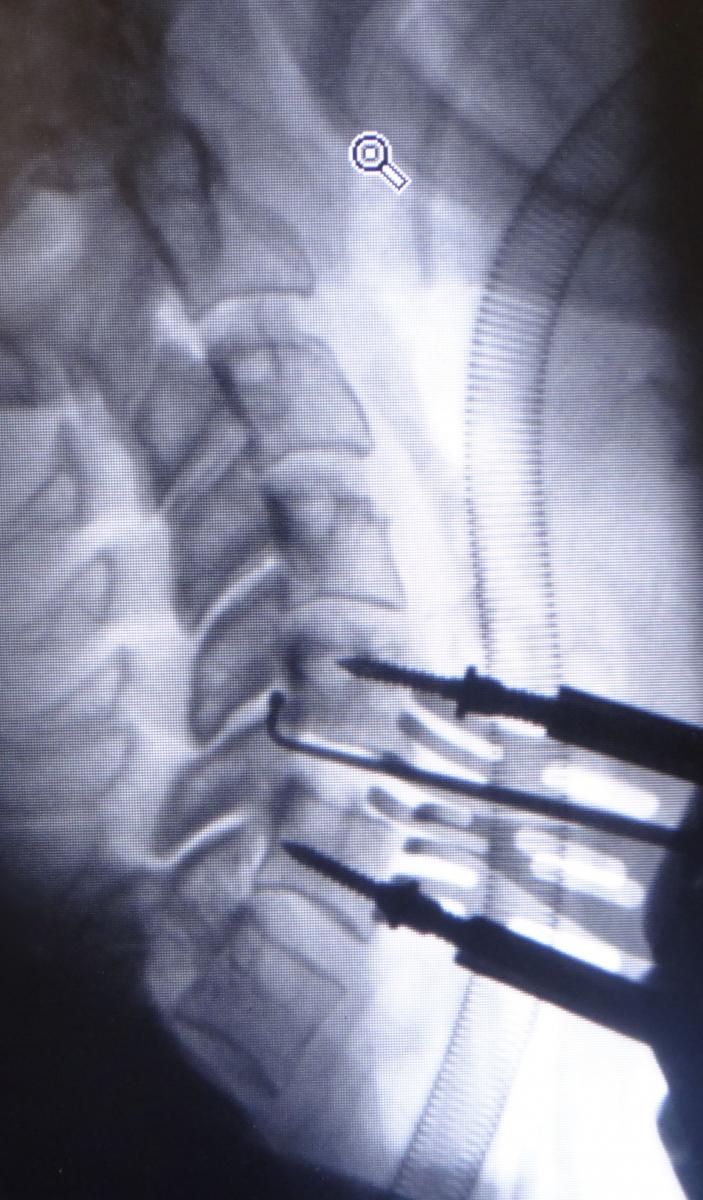 -
-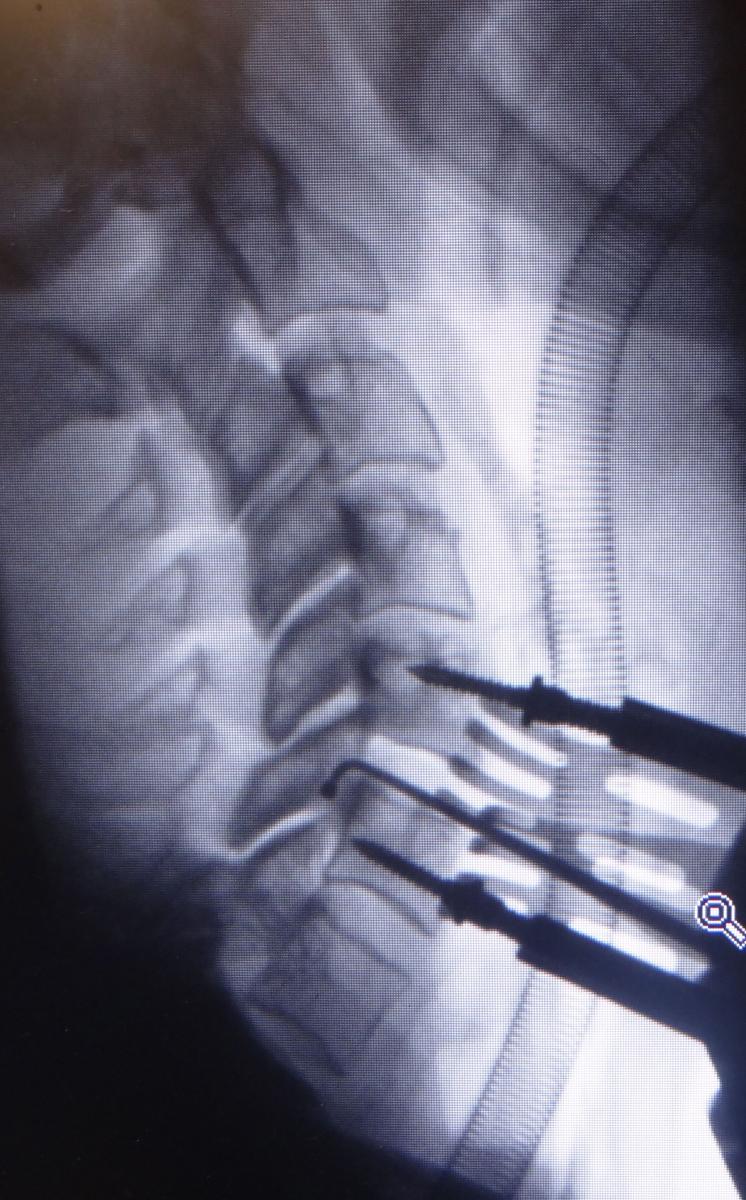
Fig 3. Probe passed into the canal following discectomy and PLL removal.
In case of fusion, a cage and bone graft are inserted and tapped into the space (Fig 4).
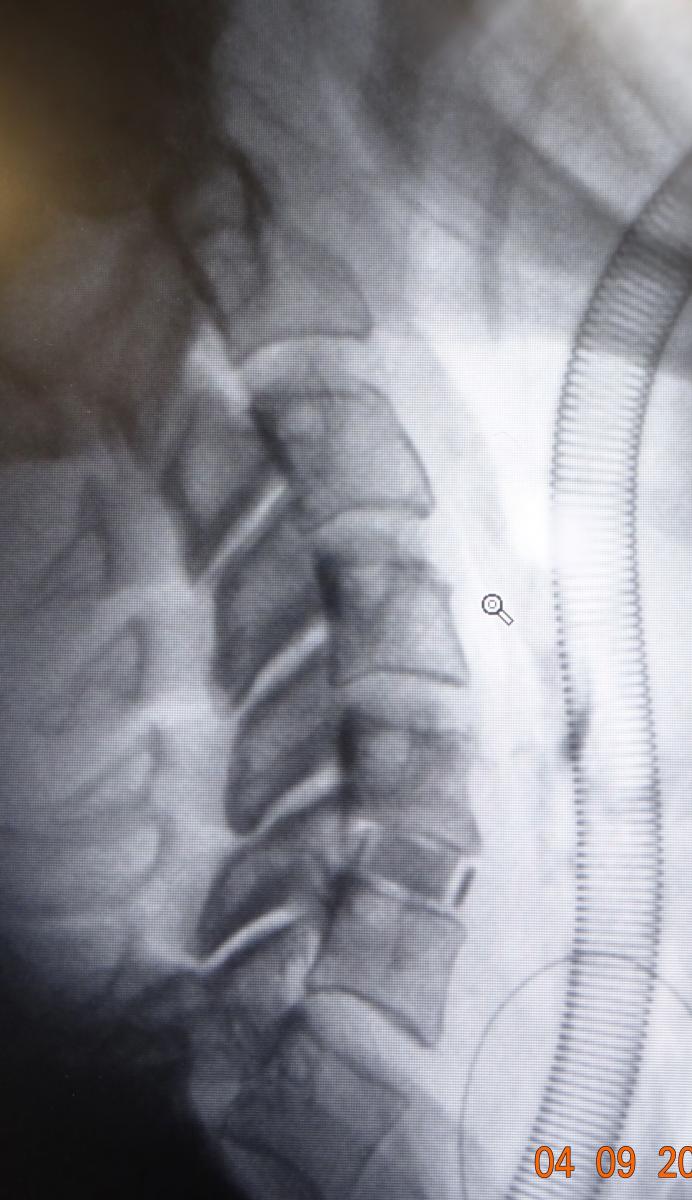
Fig 4. C5-C6 ACDF
Alternatively, a disc replacement can be inserted instead of the cage and bone graft in order to preserve motion and decrease the risk of developing adjacent disc disease.
What happens after surgery?
You will wake up in the recovery room. Your vital signs will be monitored. Any pain will be addressed.
You will increase your activity level (sitting in a chair, walking) either on the evening of the surgery or the next day. The drain will be removed on the 1st postoperative day. Most patients having a 1 or 2 level ACDF are sent home the next postoperative day. However, if there are any concerns, you may have to stay in the hospital a bit longer.
Discharge instructions
Discomfort
After surgery, pain is managed with narcotic medication for a limited period (1-2 weeks).
Hoarseness, sore throat, or difficulty swallowing may occur in some patients and should not be cause for alarm. These symptoms usually resolve in 1 to 4 weeks.
Restrictions
If you had a fusion, do not use non-steroidal anti-inflammatory drugs (NSAIDs) (e.g., aspirin; ibuprofen) for 4 months after surgery, as NSAIDs may cause bleeding and interfere with bone healing.
Do not smoke. Smoking delays healing by increasing the risk of complications (e.g., infection) and inhibits the bones' ability to fuse.
Avoid sitting for long periods of time.
Avoid bending your head forward or backward.
Do not drive for 2 to 4 weeks after surgery as your car insurers require you to be in full control of your car at all times without being distracted by pain . You are also required to be able to look over your shoulders otherwise you are considered unsafe to drive. DVLA require you to make an emergency stop.
You should not fly for 2 weeks following surgery.
Activity
You may need help with daily activities (e.g., dressing, bathing), but most patients are able to care for themselves right away.
Gradually return to your normal activities. Walking is encouraged; start with a short distance and increase it gradually . A physical therapy programme may be recommended.
If applicable, know how to wear a cervical collar before leaving the hospital. Wear it when walking or riding in a car.
Bathing/Incision Care
You may shower 1 to 4 days after surgery. Keep the dressing on for 10 days after surgey and dab it dry if it gets wet.
When to Call Your Doctor
- If your temperature exceeds 38 degrees, or if the incision begins to separate or show signs of infection, such as redness, swelling, pain, or drainage.
- If your swallowing problems interfere with your ability to breathe or drink water
Recovery and prevention
You will be reviewed in the clinic 4-6 weeks after surgery. Recovery time generally lasts 4 to 6 weeks. X-rays may be taken after several weeks to verify that fusion is occurring. Your fitness to go back to work will be decided at your follow-up visit.
A cervical collar or brace is sometimes worn during recovery to provide support and limit motion while your neck heals or fuses. You will be referred to have physical therapy once your neck has healed.
What are the results?
Anterior cervical discectomy is successful in relieving arm pain in approximately 90 to 100% of patients . However, arm weakness and numbness may persist for weeks to months and at times may not recover. Neck pain is relieved in 73 to 83% of patients. In general, people with arm pain benefit more from ACDF than those with neck pain. Aim to keep a positive attitude and diligently perform your physical therapy exercises.
